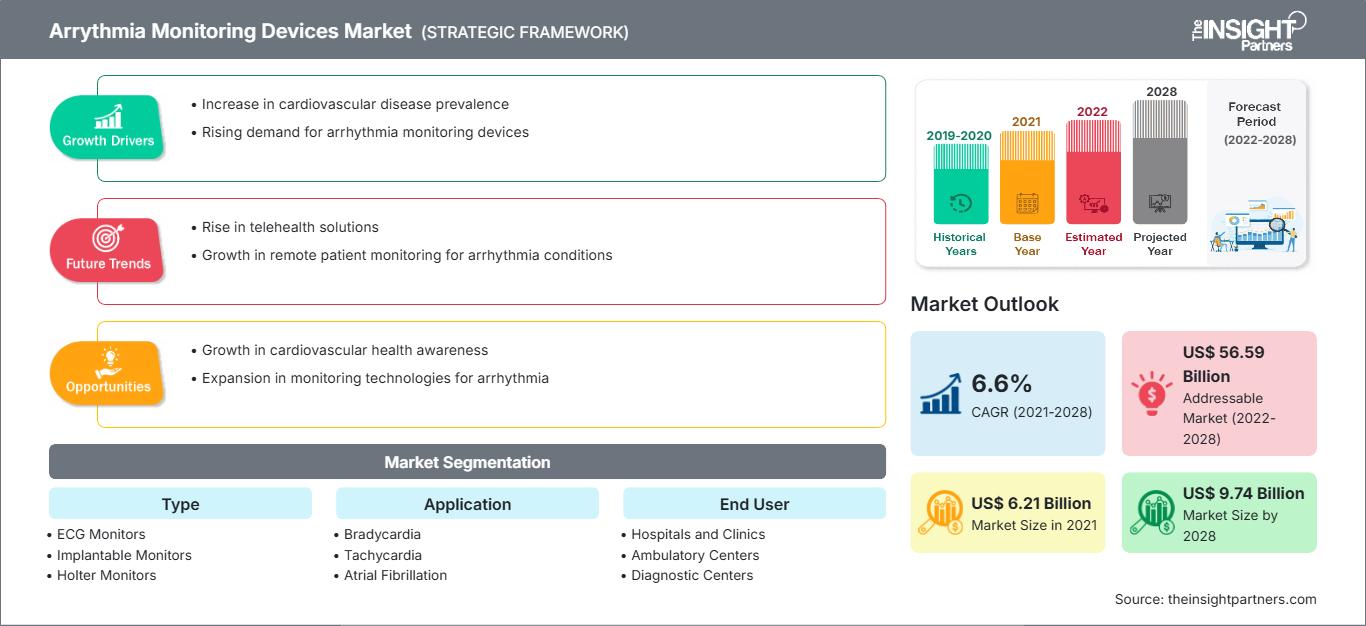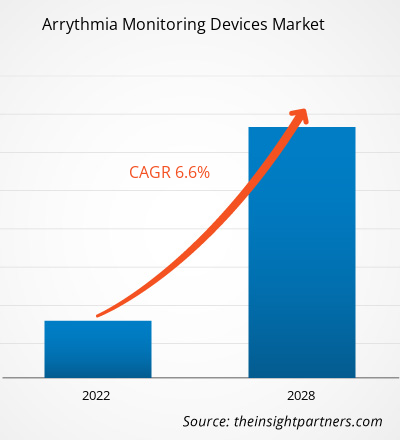Der Markt für Geräte zur Überwachung von Arrhythmien soll von 6.212,59 Millionen US-Dollar im Jahr 2021 auf 9.742,95 Millionen US-Dollar im Jahr 2028 anwachsen; von 2021 bis 2028 wird ein CAGR-Wachstum von 6,6 % erwartet.
Die Zunahme von Herz-Kreislauf-Erkrankungen und die zunehmende Zahl geriatrischer Patienten sind die Hauptfaktoren für das Marktwachstum. Die hohen Kosten der Produkte und Verfahren bremsen jedoch das Marktwachstum. Arrhythmie bezeichnet Unregelmäßigkeiten im Herzschlag, bei denen das Herz zu schnell oder zu langsam schlagen kann. Geräte zur Überwachung von Arrhythmien werden eingesetzt, um die Herzfunktion kontinuierlich zu dokumentieren und etwaige Anomalien im Herzrhythmus zu melden.
In den Asien-Pazifik-Ländern steigt die Zahl der COVID-19-Fälle. Die COVID-19-Pandemie hat kurzfristig die Notwendigkeit einer Überarbeitung der Regulierungsprozesse und von Änderungen in den Forschungs- und Entwicklungsprozessen unterstrichen. Darüber hinaus ist die Zahl der stationären und ambulanten Besuche bei privaten Krankenhausketten deutlich zurückgegangen. Um die Gesundheitssysteme zu entlasten, verschieben viele Kliniken nicht-kritische Herzoperationen. Laut einem Bericht des British Journal of Surgery werden in Indien schätzungsweise 48.728 Operationen pro Woche abgesagt. Diese Ereignisse dürften sich negativ auf den Markt für Arrhythmie-Monitoring-Geräte im asiatisch-pazifischen Raum auswirken.
Passen Sie diesen Bericht Ihren Anforderungen an
Sie erhalten kostenlos Anpassungen an jedem Bericht, einschließlich Teilen dieses Berichts oder einer Analyse auf Länderebene, eines Excel-Datenpakets sowie tolle Angebote und Rabatte für Start-ups und Universitäten.
Markt für Arrhythmie-Überwachungsgeräte: Strategische Einblicke

-
Holen Sie sich die wichtigsten Markttrends aus diesem Bericht.Dieses KOSTENLOSE Beispiel umfasst Datenanalysen, die von Markttrends bis hin zu Schätzungen und Prognosen reichen.
Weltweit hat es im letzten Jahrzehnt bemerkenswerte Entwicklungen bei Geräten zur Arrhythmieüberwachung gegeben, die Ärzten und Patienten neue Ansätze zur Behandlung vieler Krankheiten bieten, darunter Vorhofarrhythmien, Kammerarrhythmien und ventrikuläres Vorhofflimmern. Die zunehmende Verbreitung von Arrhythmien und anderen Herz-Kreislauf-Erkrankungen (HKE) wie Bradykardie, Tachykardie, Vorhofflimmern, Kammerflimmern und vorzeitiger Kontraktion fördert die Einführung verbesserter Diagnosemethoden. Herzüberwachungssysteme sind einfachere und schnellere Werkzeuge zur Erkennung von Arrhythmien, was zu ihrer Beliebtheit beigetragen hat. Laut der Weltgesundheitsorganisation (WHO) gehören HKE zu den häufigsten Todesursachen weltweit, und jährlich erleiden etwa 30 Millionen Menschen einen Schlaganfall. Laut der American Heart Association leidet fast die Hälfte aller Erwachsenen in den USA an einer HKE. Darüber hinaus wird prognostiziert, dass bis 2035 mehr als 130 Millionen Menschen, also 45,1 % der US-Bevölkerung, an einer Herz-Kreislauf-Erkrankung leiden werden. Veränderungen im Lebensstil führen zudem zu einer Zunahme von Krankheiten wie Diabetes, Bluthochdruck, Dyslipidämie und Fettleibigkeit, was wiederum zu einem Anstieg der Herz-Kreislauf-Erkrankungen weltweit beiträgt. Die meisten Arten von Herz-Kreislauf-Erkrankungen können durch Vorüberwachung und Vordiagnose verhindert werden. Ebenso können Arrhythmien, also Anomalien der Herzfunktion, durch eine frühzeitige Diagnose vermieden werden. Die Nachfrage nach Geräten zur Arrhythmieüberwachung steigt, da diese Geräte dazu beitragen können, Patienten zu retten, die einem hohen Risiko eines Herzinfarkts ausgesetzt sind.
Typbasierte Erkenntnisse
Basierend auf dem Typ ist der Markt für Geräte zur Arrhythmieüberwachung in EKG-Monitore, implantierbare Monitore, Holter-Monitore, mobile Kardiotelemetrie und andere Geräte unterteilt. Das Segment der Langzeit-EKG-Geräte hatte 2020 den größten Marktanteil. Langzeit-EKG-Geräte gehören zu den beliebtesten Geräten für die Herzüberwachung. Diese Geräte ermöglichen den Langzeiteinsatz zur Diagnose sporadischer Symptome und bieten eine schnellere und bequemere Überwachung. Das Segment der mobilen Herztelemetrie wird zwischen 2021 und 2028 voraussichtlich die höchste CAGR aufweisen.Anwendungsbasierte Erkenntnisse
Der Markt für Geräte zur Arrhythmieüberwachung ist nach Anwendung in Bradykardie, Tachykardie, Vorhofflimmern, Kammerflimmern, vorzeitige Kontraktion und weitere unterteilt. Das Segment Vorhofflimmern hatte 2020 den größten Marktanteil und wird im Prognosezeitraum voraussichtlich die höchste CAGR verzeichnen. Das Marktwachstum im Bereich Vorhofflimmern ist auf die zunehmende Prävalenz von Vorhofflimmern und die zunehmende Alterung der Bevölkerung zurückzuführen.
Endnutzerbasierte Erkenntnisse
Basierend auf den Endnutzern ist der Markt für Geräte zur Arrhythmieüberwachung in Krankenhäuser und Kliniken, ambulante Zentren, Diagnosezentren und andere segmentiert. Das Segment Krankenhäuser und Kliniken hatte 2020 den größten Marktanteil. Die steigende Zahl von Krankenhäusern mit mehreren Fachrichtungen und die Bevorzugung von Krankenhäusern gegenüber anderen Gesundheitseinrichtungen sind die Haupttreiber des Marktwachstums im Segment Krankenhäuser und Kliniken. Es wird jedoch erwartet, dass das Segment der ambulanten Zentren im Prognosezeitraum die höchste durchschnittliche jährliche Wachstumsrate (CAGR) verzeichnen wird.Unternehmen, die im Markt für Geräte zur Arrhythmieüberwachung tätig sind, legen Wert auf die Umsetzung einer Produktinnovationsstrategie, um den sich weltweit wandelnden Kundenanforderungen gerecht zu werden und so ihren Markennamen auf dem Weltmarkt zu behaupten.
Geräte zur Arrhythmieüberwachung
Regionale Einblicke in den Markt für Arrhythmie-ÜberwachungsgeräteDie Analysten von The Insight Partners haben die regionalen Trends und Faktoren, die den Markt für Arrhythmie-Überwachungsgeräte im Prognosezeitraum beeinflussen, ausführlich erläutert. In diesem Abschnitt werden auch die Marktsegmente und die geografische Lage von Arrhythmie-Überwachungsgeräten in Nordamerika, Europa, im asiatisch-pazifischen Raum, im Nahen Osten und Afrika sowie in Süd- und Mittelamerika erörtert.
Umfang des Marktberichts zu Geräten zur Arrhythmieüberwachung
| Berichtsattribut | Einzelheiten |
|---|---|
| Marktgröße in 2021 | US$ 6.21 Billion |
| Marktgröße nach 2028 | US$ 9.74 Billion |
| Globale CAGR (2021 - 2028) | 6.6% |
| Historische Daten | 2019-2020 |
| Prognosezeitraum | 2022-2028 |
| Abgedeckte Segmente |
By Typ
|
| Abgedeckte Regionen und Länder |
Nordamerika
|
| Marktführer und wichtige Unternehmensprofile |
|
Dichte der Marktteilnehmer für Arrhythmie-Überwachungsgeräte: Verständnis ihrer Auswirkungen auf die Geschäftsdynamik
Der Markt für Arrhythmie-Überwachungsgeräte wächst rasant. Dies ist auf die steigende Nachfrage der Endnutzer zurückzuführen, die auf Faktoren wie veränderte Verbraucherpräferenzen, technologische Fortschritte und ein stärkeres Bewusstsein für die Produktvorteile zurückzuführen ist. Mit der steigenden Nachfrage erweitern Unternehmen ihr Angebot, entwickeln Innovationen, um den Bedürfnissen der Verbraucher gerecht zu werden, und nutzen neue Trends, was das Marktwachstum weiter ankurbelt.

- Holen Sie sich die Markt für Arrhythmie-Überwachungsgeräte Übersicht der wichtigsten Akteure
- EKG-Monitore
- Implantierbare Monitore
- Holter-Monitore
- Mobile Kardiale Telemetrie
- Sonstige
Markt für Arrhythmie-Überwachungsgeräte – nach Anwendung
- Bradykardie
- Tachykardie
- Vorhofflimmern
- Kammerflimmern
- Vorzeitige Kontraktion
- Sonstige Anwendungen
Markt für Arrhythmie-Überwachungsgeräte – nach Endnutzer
- Krankenhäuser und Kliniken
- Ambulante Zentren
- Diagnosezentren
- Sonstige Endnutzer
Markt für Arrhythmie-Überwachungsgeräte – nach Geografie
-
Nordamerika
- USA
- Kanada
- Mexiko
-
Europa
- Frankreich(APAC)
- China
- Indien
- Südkorea
- Japan
- Australien
- Rest von APAC
-
Naher Osten und Afrika (MEA)
- Südafrika
- Saudi-Arabien
- VAE
- Rest von MEA
-
Süd- und Mittelamerika (SCAM)
- Brasilien
- Argentinien
- Rest von SCAM
Unternehmensprofile
- Abbott
- Koninklijke Philips NV
- General Electric Company
- Hill-Rom Holding Inc.
- Medtronic
- Biotronik, Inc.
- AliveCor, Inc
- ACS Diagnostics
- Medicalgorithmics
- OSI Systems, Inc
- Frankreich(APAC)
- Historische Analyse (2 Jahre), Basisjahr, Prognose (7 Jahre) mit CAGR
- PEST- und SWOT-Analyse
- Marktgröße Wert/Volumen – Global, Regional, Land
- Branchen- und Wettbewerbslandschaft
- Excel-Datensatz
Aktuelle Berichte
Erfahrungsberichte
Grund zum Kauf
- Fundierte Entscheidungsfindung
- Marktdynamik verstehen
- Wettbewerbsanalyse
- Kundeneinblicke
- Marktprognosen
- Risikominimierung
- Strategische Planung
- Investitionsbegründung
- Identifizierung neuer Märkte
- Verbesserung von Marketingstrategien
- Steigerung der Betriebseffizienz
- Anpassung an regulatorische Trends






















 Kostenlose Probe anfordern für - Markt für Arrhythmie-Überwachungsgeräte
Kostenlose Probe anfordern für - Markt für Arrhythmie-Überwachungsgeräte